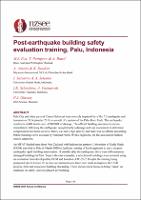| dc.contributor.author | Fox, Matthew | |
| dc.contributor.author | Pettigrew, Tony | |
| dc.contributor.author | Baird, Andrew | |
| dc.contributor.author | Glassey, Phil | |
| dc.contributor.author | Amaris, Alejandro | |
| dc.contributor.author | Sanders, Rebecca | |
| dc.contributor.author | Satyarno, Iman | |
| dc.contributor.author | Setianto, Agung | |
| dc.contributor.author | Sulendra, Ketut | |
| dc.date.accessioned | 2021-06-22T04:01:52Z | |
| dc.date.available | 2021-06-22T04:01:52Z | |
| dc.date.issued | 2021-04-14 | |
| dc.identifier.uri | https://repo.nzsee.org.nz/xmlui/handle/nzsee/2355 | |
| dc.description.abstract | Palu City and other parts of Central Sulawesi were severely impacted by a MW 7.5 earthquake and tsunamis on 28 September 2018 as a result of a rupture of the Palu–Koro Fault. The earthquake resulted in 4,400 deaths and ~US$910M damage. The official building assessment process, immediately following the earthquake, was primarily a damage and loss assessment to determine compensation for home-owners. Safety was not a high priority and there was no official placarding. Public buildings were assessed by National Public Works engineers, but the assessment method used is unknown.
An MFAT funded team from New Zealand, with Indonesian partners UGM travelled to Palu in March 2020 to facilitate training of local engineers to carry out post-earthquake rapid building assessments. 18 months after the earthquake, there were still numerous damaged buildings in Palu. To provide case examples, a selection of buildings were assessed using an evaluation form developed by UGM and based on ATC-20-2. Despite the training being postponed due to Covid-19, several recommendations have been made to improve the UGM process, form and associated building placarding. These include more focus on being ‘rapid,’ an emphasis on safety, and one placard per building.
The buildings assessed were typical reinforced concrete frames with unreinforced masonry infill walls, and recurring observations were made of construction detailing that led to poor seismic performance or made post-earthquake assessment difficult. Significant improvements in seismic resilience could be gained from relatively minor changes to building construction and the consideration of seismic design for non-structural elements. | |
| dc.language.iso | en | |
| dc.publisher | New Zealand Society for Earthquake Engineering | |
| dc.relation.ispartofseries | 2021;0064 | |
| dc.subject | Better building management in emergencies | |
| dc.subject | Society, policy, and culture in understanding impacts and improving resilience | |
| dc.title | Post-earthquake Building Safety Evaluation Training, Palu, Indonesia | |
| dc.type | Article | |

